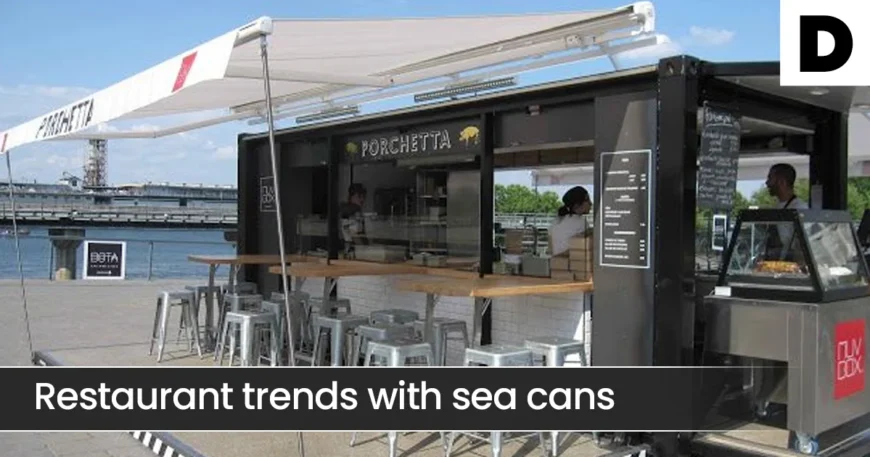Social media is a very important part of today’s fast-moving world. All information is available to us at just a click of a button. It has become a part of everyday life, influencing how people discover trends, choose places to eat, and share experiences. The food industry is always trying to use this to its advantage by finding innovative ways to serve customers and create a newer ambiance for their ever-evolving social life.
In this case, shipping containers might be a novel and distinctive experience for both clients and owners. Sea Can Restaurants for Stylish and Sustainable Dining are redefining food trends with eco-friendly, mobile, and eye-catching designs. they can be transformed into stylish cafes and restaurants with bold designs, imaginative layouts, and a variety of themes including movies, TV series, anime, cuisines, nations, and locations.
Since these repurposed containers are an affordable, eco-friendly, and fashionable substitute for conventional restaurants, they are rapidly gaining popularity. Their modular design enables infinite customization—perfect for entrepreneurs. Instagrammers, TikTokers, and food bloggers searching for visually striking content are naturally drawn to these setups.
Sea cans can be turned into themed cafes which attract a wide range of customers and provide free promotion through social media sharing.
Why Choose a Shipping Container for Your Restaurant or Café?
1. Cost-Effective Business Model
- Traditional cafes involve large expenses like high rents, utility charges, and maintenance.
- Start-up costs for traditional restaurants may reach CAD 300,000.
- Shipping container cafés cost between CAD 50,000 and CAD 150,000.
- They require fewer modifications, saving on materials, labor, and permits.
- Mobile or semi-permanent designs reduce long-term rental obligations.
2. Sustainability and Eco-Friendliness
- The carbon footprint of a restaurant can reach 70 metric tons.
- Using shipping containers is a great example of upcycling.
- They require less maintenance due to durable steel structures.
- Eco-friendly additions include solar panels, efficient appliances, and recycled decor.
3. Mobility and Flexibility
- Location is key—shipping containers offer the flexibility to relocate.
- Participate in events, festivals, and markets easily.
- Modular design allows easy expansion (e.g., more seating or rooftop areas).
- More capital can be allocated for marketing and growth.
4. Unique and Eye-Catching Design
- Industrial-modern style is attractive to urban diners.
- Highly customizable for different aesthetics and themes.
- Options include rooftop dining, open patios, and artistic exteriors.
- Appealing to customers looking for Instagrammable spots.
Minimalist to Maximalist: Sea Can Restaurants for Stylish and Sustainable Dining
1. Pop-Up Street Food Stalls
- Concept: Serve burgers, tacos, dumplings, etc.
- Ideal Setup: Food festivals, markets, and universities.
- Social Appeal: Vibrant branding and open service windows.
2. Themed Cafés
- Concept: Themes like Marvel, anime, retro, books, or transportation.
- Why It Works: Emotional connections and fan loyalty.
- Social Appeal: Instagrammable with murals and decor.
3. Rooftop Container Bar & Grill
- Concept: Stacked containers with dining on top.
- Why It Works: Utilizes vertical space creatively.
- Social Appeal: Rooftop views and sunset vibes.
4. Coastal or Beachside Seafood Shacks
- Concept: Set up near beaches for casual seafood dining.
- Why It Works: Withstands coastal weather, easy setup.
- Social Appeal: Rustic seafood photos with ocean backdrops.
5. Drive-Thru Coffee & Donut Shops
- Concept: Small containers for fast, efficient service.
- Why It Works: Minimal staff and overhead costs.
- Social Appeal: Trendy aesthetics and branded visuals.
6. International Food Court Pods
- Concept: Clustered containers with varied cuisines.
- Why It Works: One-stop for global tastes.
- Social Appeal: Fusion culture and colorful variety.
7. Art Café or Music Lounge
- Concept: Serve coffee with art shows or live music.
- Why It Works: Appeals to creative communities.
- Social Appeal: Events, moody lighting, artistic vibes.
8. Ice Cream & Dessert Bar
- Concept: Compact dessert hubs with colorful treats.
- Why It Works: Low-cost and popular among youth.
- Social Appeal: Neon signs and aesthetic presentation.
Conclusion
Turning shipping containers into trending taverns and food joints is a smart, sustainable, and stylish business idea. Whether you’re launching a pop-up café or a full-fledged eatery, using Sea Can Restaurants for Stylish and Sustainable Dining is redefining food trends with eco-friendly, mobile, and eye-catching designs. Also, sea cans offer flexibility, cost-efficiency, and endless branding opportunities—perfect for attracting today’s social media-savvy customers.



